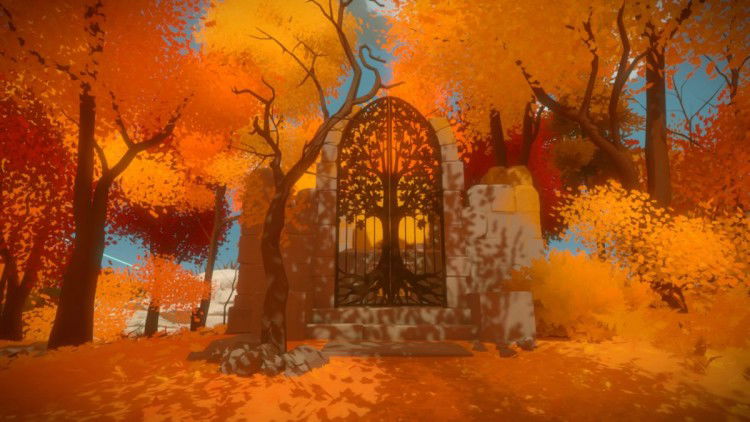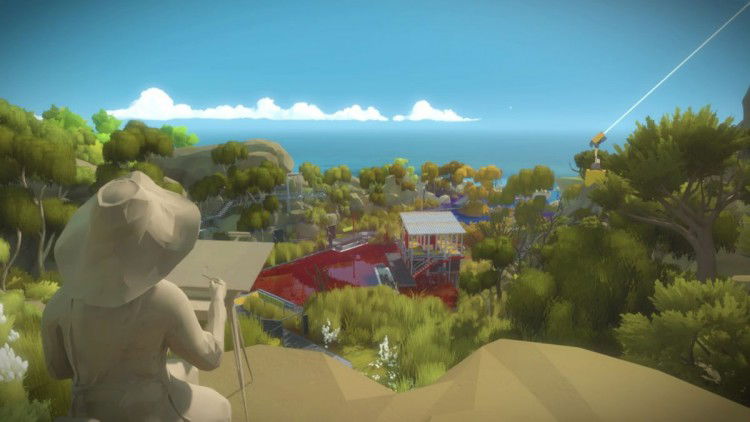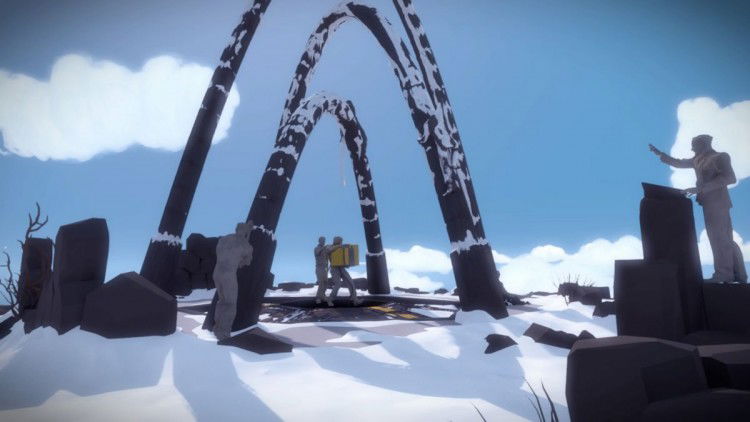As I sat in front of my television, having just finished The Witness, a funny thing occurred to me. I looked down to my left, and on my coffee table was a small moleskin notebook, in which I had drawn out many of the game’s tougher puzzles that needed more time to solve than my play sessions would allow. This had been a natural thing while I played, and I didn’t think twice. But in retrospect, I’ve never done this for a video game. To be honest, had I known that I would beforehand, I most likely would have slowly backed away from the title. That doesn’t sound fun, I would have thought. I would have been wrong.
Game Name: The Witness
Platform(s): PS4 (Reviewed), PC
Publisher(s): Thekla, Inc.
Developer(s): Thekla, Inc.
Release Date: 1/26/2016
Price: $39.99 (USD)
The latest game from Jonathan Blow, the man behind the surprisingly successful Braid, The Witness openly takes its cues from classic puzzle-adventures like Myst and throws the player on an island with no context and asks the player to forge their own path forward. It only has a single mechanic-panels spread across the map with puzzles that simply ask the player to draw a line from point A to point B. If only it was indeed that simple.
I soon found an increasing amount of rules piled into the mix, and even found that the game is not afraid to bend those rules when need be. Along the way, I bore…ahem…witness to a beautifully detailed, colorful geography that begged me to complete the next puzzle at every turn in hopes that a new area would open up to me. Bringing it all together are mysterious pieces of technology, petrified (literally) artists, and strange iconography littered about that begged me to question what this island was and why I was there.
It was those questions that really helped drive me through the most challenging puzzles The Witness threw at me (and don’t underestimate that challenge). But they weren’t the sole factor. The design of each puzzle, not just individually, but as a piece of a larger whole, as well as the pacing of it all, is really an achievement to be admired on its own.
I’m by no stretch of the imagination an aficionado of puzzle games (in fact, I can’t remember if I’ve even played one since Tetris on the original Gameboy). Yet the game eases you into its rules: the first area is very easy, introducing you to the ultimate objective of every puzzle in the game. Then, slowly but surely, each subsequent sequence of puzzles layers on a new symbol or layout onto the formula, making sure to introduce it safely, then testing your mental agility before moving on to the next rule. Playing the game was almost like learning a new language, and somehow it was designed well enough that by the end of it I was still able to remember it all and how it fits together. This is before you even begin talking about how the environment plays a role, and certain rules introduced that are specific to certain areas. Your expectations are constantly being challenged, and it keeps the game feeling consistently fresh. I would never want to spoil the secrets of The Witness knowingly, so I will only say this: keep your eyes and ears open at all times.
This should not be a problem, however, because this game is a looker, and the level of detail is astounding. Obviously, there is a certain artistic style being used that forgoes realism (and the game benefits from the simplicity), but every sliced apple left on a rock, and every empty beach chair beside a towel reminds me of how much care was put into building the environment. There is also a great deal of variety, ranging from snowy mountain tops to deserts, pagodas, jungles and so on. It is very easy to forget how small the island actually is, as there is so much depth, both figuratively and literally (there are nooks and crannies galore, waiting to be explored).
Granted, there are imperfections. While the slow pace at which your character moves usually allows the world to present itself in its perfect self, cutting corners a little too fast can cause some pop-in. On closer observation, I also noticed some aliasing issues. However, by and large, the vistas in The Witness are exceptional.
Sound design stuck out as well, surprisingly. From the soothing sound of a waterfall to birds chirping in a jungle, these soon became instantly recognizable call signs of where I was in the world. Ambiance is used sparingly, but well. The greater perception may be a result, however, of the game’s usual silence. Aside from “dead drops” found throughout the game in the form of readings of obscure quotes, there is no soundtrack or narration to really speak of. While these recordings can be fun and interesting to listen to, often times they can be…self-indulging. I realize you are trying to touch on some big stuff, Mr. Blow, but certainly there are other quotes that would have said the same thing in a more succinct manner. Some of these quotes feel like they are hitting the ten minute mark, and caused me to stop caring rather than listen intently to garner some deeper meaning.
This leads me to the final question one could have: did I find answers to those questions that were driving me? Without spoiling anything, I will say I was not satisfied in that sense, and I would caution anyone playing this game for a meaningful resolution. You will hear a lot about how the game challenges you to forge your own story, or that it allows for various interpretations from the community. Those are legitimate claims, but solid storytelling it is not. However, while my frustration was intense upon reaching the game’s conclusion, thinking back upon it I do appreciate how The Witness uses gameplay to form a meta-narrative of sorts (at least, that was how I “interpreted” it). If anything, though, that is a reflection on the excellent design that I have already expounded upon, not proper writing.
Frustrating, But Worth It
Summary
Whether it be through its hellish difficulty or the desire I was left with by the game’s end, The Witness caused some serious pain in this gamer’s heart. However, I go back to those first few lines of this review, and I remember that it was all worth it, because the in-game, moment to moment experience was really unlike anything I’ve played in a long time. Using my handy dandy notebook to solve puzzles in such an intricately assembled playground made me feel more like Indiana Jones than Uncharted ever has. In my opinion, what’s here to play is a masterclass in game design, and there are 600 of these puzzles. Considering you need less than half of that to “beat” the game (an endeavor that will take one, unguided, around 20-30 hours to complete), there is more than enough value here to justify the price of admission. There are areas that require multiple playthroughs and precise sequencing to unlock. The only question gamers will have to answer is if they’re okay with playing the game for its own sake, not necessarily to have their questions answered. Thinking back on those overbearing in-game quotes, perhaps that is the point.
-
Truly Sublime




